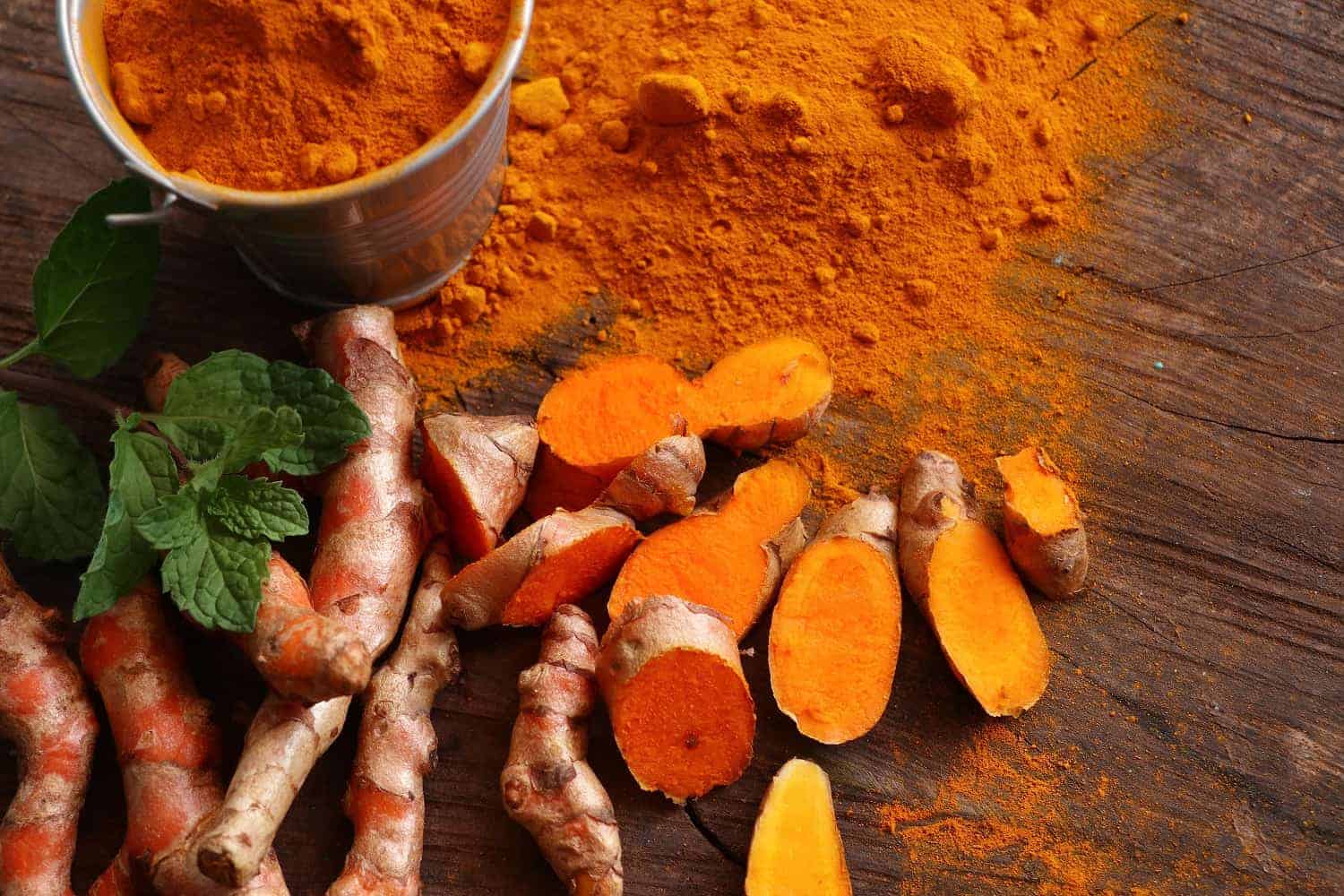Turmeric, a golden bright yellow spice that comes from a root and is commonly found in curries, Golden Milk lattes, and mustards, has been dubbed a “superfood.”
The buzzword “superfood” is defined by the Merriam-Webster dictionary as:
- A food (such as salmon, broccoli, or blueberries) that is rich in compounds (such as antioxidants, fiber, or fatty acids) considered beneficial to a person’s health.
When searching through turmeric products online, you’ve probably seen the term “superfood” on various packaging. While the term superfood may be used as a strategic marketing tactic by numerous companies, are there actually benefits to consuming this golden spice?
Let’s explore all things turmeric in this blog post. If you’re interested in:
- A brief history of turmeric
- The difference between turmeric and curcumin
- The health benefits of turmeric
- The mechanisms of how turmeric works in the body
- A recipe with turmeric
Curry on and keep reading!
A Brief History of Turmeric
Plants and herbs have been used to combat disease for centuries. And one of the oldest spices used in the Western and Southern parts of India is turmeric. Turmeric is also known as:
- Turmeric root
- Indian saffron
- Curcuma longa
- Curcuma aromatica
Originating in India, this spice was used in Ayurveda, the Indian system of holistic medicine, to treat various ailments – including cancer. Historians aren’t 100% sure, but turmeric most likely made its way to China by 700 AD, East Africa by 800 AD, West Africa by 1200 AD, and Jamaica in the 1700 AD.
Today it’s a popular spice in the same plant family as ginger. It’s grown in tropical climates and used throughout the world. The turmeric plant needs to grow in temperatures between 20-30°C (68-86°F) and in an area that receives a considerable amount of rainfall.
The world’s largest producer of turmeric is Erode, a city in Tamil Nadu (Southern Indian state). It’s commonly used in foods, cosmetics, and medicine. Some examples of food that contain turmeric from Indian and Middle Eastern countries include:
- Cheese and butter (for coloring)
- Boiled rice
- Curry powders
If you’ve done any research on turmeric, you’ve probably come across the term “curcumin.” But are these two compounds the same? Let’s explore that next.
Are Turmeric and Curcumin the Same Thing?
The short answer: no.
Curcumin is a major component of turmeric that gives the spice its yellow pigment. Curcumin is a curcuminoid, a group of active compounds in turmeric that provide its medicinal benefits.
Curcuminoids are also phenolic compounds that may protect against tumor formation, inflammation, nerve cell damage, and/or injurious effects of radiation.
Curcuminoids may also provide therapeutic roles in chronic diseases like certain cancers and autoimmune diseases.
You can consume curcumin by consuming turmeric itself. Pure turmeric powder has the highest curcumin concentration (3.14%). If your practitioner has advised you to consume a larger amount of curcumin, you will want to consider taking curcumin supplements, as it would be pretty impossible to consume enough turmeric powder to get to therapeutic dosing.
Your body may have a hard time absorbing turmeric or curcumin, so consider pairing any food containing turmeric or curcumin with black pepper and/or an oil or lipid carrier. Black pepper contains piperine, an alkaloid and lipid carrier that enhances curcumin’s bioavailability. Bioavailability is your body’s ability to absorb and use a substance. There are also some interesting theories about how your gut bacteria play a role in the absorption and bioavailability of curcumin as well.
The Benefits: What Turmeric is Good For
It’s clear that turmeric and curcumin provide health benefits when consumed. In Ayurvedic medicine, turmeric was known to have medicinal properties such as improving digestion, dissolving gallstones, relieving arthritis, and regulating menstruation. We also know that turmeric has gained media attention for its anti-inflammatory properties. But do scientific studies support these findings?
Let’s explore the conditions that turmeric and curcumin have been used for in more detail.
- Pain
Pain is caused by unpleasant emotional or sensory experiences associated with actual or potential tissue damage. While pain is subjective and is difficult to quantify, this doesn’t diminish the benefits that curcumin and turmeric have for patients dealing with pain.
Turmeric eases stomach pain while curcumin has helped reduce pain and stiffness in joints. Turmeric has also been used with dental problems – dentists massaged aching teeth with ground turmeric to eliminate pain and swelling. It may also reduce the pain from osteoarthritis, menstrual cramping, and intestinal pain.
I recommend curcumin and turmeric for my patients to with pain management.
- Inflammatory and Autoimmune Diseases
Inflammation is highly linked to pain. Inflammation normally occurs as your body’s natural defense mechanism against injury or infection. Signs of inflammation include redness, swelling, heat, and/or pain.
Curcumin has shown effectiveness for inflammatory diseases like periodontitis, inflammatory bowel disease, osteoarthritis, rheumatoid arthritis, uveitis (eye inflammation), and bronchial asthma. Curcumin 500mg twice daily can help reduce inflammation and help your body respond to infections early.
Numerous studies have shown that curcumin is effective against autoimmune diseases. One example where curcumin is effective against an autoimmune disorder is psoriasis.
Psoriasis is a skin disease that causes red, itchy patches. A study found that patients treated with curcumin showed reduced psoriasis conditions and served as an adjuvant therapy (a therapy used after primary treatments) against psoriasis.
- Immune Support
It’s important to support your immune system to protect your body against pathogens and protect those around you. I recommend curcumin because it works on your immune system via 11 different mechanisms. We’ll explore turmeric and curcumin’s benefits in autoimmune disease next.
- Cardiovascular Diseases
The number one cause of death worldwide is by cardiovascular diseases. While there are medications to treat them, they come with varying side effects. Curcumin has been studied as a functional medicine approach to treat patients with cardiovascular diseases.
Curcumin was shown to reduce the total cholesterol and low-density lipoprotein (LDL) cholesterol levels. Curcumin may also prevent LDL oxidation. This is important because oxidized LDL may contribute to the formation of atherosclerosis (plaques in the arteries).
We don’t want anything to restrict blood flow, so curcumin may help to prevent this from happening.
- Cancer
We learned that curcumin may give your immune system support. But did you know curcumin can also boost your immune system so that cancer cells are destroyed and eliminated at an earlier stage? This can potentially help prevent metastasis or spreading and growth of cancer cells.
In addition curcumin has been studied in pancreatic cancer, head and neck cancer, colon cancer, breast cancer, lung cancer, and cervical cancer.
It’s amazing just how many health benefits this golden spice has on our bodies. But how exactly does it work in the body? Keep reading to learn its mechanisms of action.
Mechanisms of Action: How Turmeric Works in the Body
So you’ve decided to incorporate turmeric and curcumin in your cooking or through supplementation. But how exactly does turmeric and curcumin work in your body?
Studies have shown that turmeric and curcumin have many mechanisms of action and have numerous targets in the body. Curcumin has properties that can change the activity of your growth factor receptors, enzymes, and other molecules.
While research is still being conducted, there are several mechanisms of action that specifically curcumin have at the cellular level. Here are 3 examples:
- Curcumin’s mechanism in intervening in oxidative stress.
- Curcumin can increase a cell’s ability to defend itself against stress.
- Curcumin’s mechanism in intervening in inflammation.
- Curcumin can switch off mechanisms that are involved in inflammation. For example, curcumin can inhibit the NF-κB signaling pathway, a proinflammatory pathway.
- Curcumin’s mechanism of action in Alzheimer’s Disease.
- Curcumin inhibits the formation of amyloid-𝛃 plaques. It also promotes the disaggregation of amyloid-𝛃 plaques. This protein is the main component of amyloid plaques that are found in the brains of patients with Alzheimer’s Disease.
If you’re interested in learning more about the various pharmacological actions of curcumin and turmeric in varying diseases, you can read more about them here.
Turmeric Recipe
If you’re looking for an easy way to incorporate turmeric into your diet, consider my favorite Super Turmeric Golden Milk latte. It contains coconut milk, cashew milk, black pepper, and MCT oil and/or C8 oil that will increase the absorption of turmeric and curcumin. These oils also provide some antiviral and antifungal benefits.
Want to Learn More About This Amazing Superfood?
While “superfood” may be an overused term to get people to buy products, turmeric is the real deal.
From its rich history in Indian cooking to our Golden Milk lattes today – this spice is worth incorporating into your everyday cooking. You can also consider supplementing with turmeric. And be sure to pair turmeric with black pepper or an oil to increase absorption.
For more resources on turmeric, visit my blog. You can also follow me on Instagram. Be sure to tag me if you make my Golden Milk Latte.
If you’re interested in learning more about the natural therapies, call to book an appointment at 602-892-4727 or fill out our contact form.










The benefits of using turmeric for acne are varied and interesting. First, it is worth highlighting its antibacterial action capable of combating microorganisms such as P. acnes when combined with lauric acid. Its effect is compared to that of drugs such as erythromycin and clindamycin. On the other hand, this spice has anti-inflammatory effects that indicate positively on dermatological problems . While more scientific evidence is required to prove its action against acne, anecdotal evidence suggests that it is effective. Turmeric and its antioxidants also have other important effects when it comes to treating acne. Its topical application helps to repair tissues, minimizing the presence of scars . It also stimulates the production of collagen and reduces the risk of premature wrinkles.